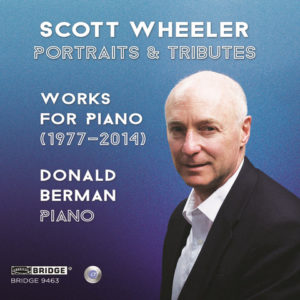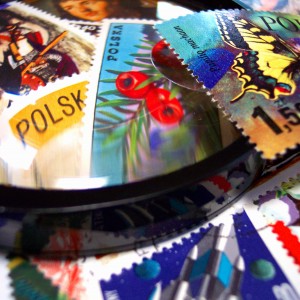Artist Portrait: Scott Wheeler
 Meet American composer and pianist Scott Wheeler. I’m very grateful to him for sharing himself so openly and for the wonderful pieces in his new album Portraits and Tributes. You can read my thoughts about the album here. Enjoy!
Meet American composer and pianist Scott Wheeler. I’m very grateful to him for sharing himself so openly and for the wonderful pieces in his new album Portraits and Tributes. You can read my thoughts about the album here. Enjoy!
What was your musical growing up like? When did you start composing and what drew you there?
I started studying piano around age 11, which is generally too late to be a virtuoso – it certainly was for me. I didn’t adore the lessons, but I adored the piano, played it constantly, probably drove my family crazy. Instead of practicing scales or assigned pieces, mostly I played by ear, at first only pop songs I knew from the radio, but quickly adding my own “songs,” most of which I never bothered to write down. I’d be curious to hear them now, but I suspect their disappearance isn’t any great loss to music. This was in the late 1960s, and I was avidly absorbing the latest music by the Beatles, the Beach Boys, all the Motown groups, and many others. The pop music I preferred was generally the kind with interesting harmonies that I could play on the piano rather than the blues-based music of groups like the Rolling Stones, good though it is. My mom had always filled our home with the recordings of Sinatra, Brubeck, and jazz pianists like Erroll Garner and Oscar Peterson, all of which I played by ear. Loving and playing rock never made me reject these earlier, more harmonically rich styles of pop and jazz. In fact I still love all those styles.
I loved some classical music too, but my exposure to it was spotty. When I got serious I about composing I found myself playing catch-up with my conservatory-trained friends and colleagues who made up the majority of that world. To some extent that catch-up is still going on – there’s plenty of classical repertoire that I’m still encountering for the first time.
I love that you spent summers as the pianist at a local eatery on Martha’s Vineyard. How did that experience influence your music?
Entertainment music is easy to dismiss, but it’s a great thing for a composer to do, for several reasons: it connects directly to untrained audiences, who shouldn’t be dismissed; playing by ear as I did is great all-around musical training; jazz improvisation (which I did pretty seriously) is a very exacting and exciting art; and the simplest entertainment music can be an essential element in the most complex symphony or opera. I certainly used many pop and jazz styles in composing the piano pieces on the Portraits and Tributes CD — I think it’s part of the fun and also part of the variety on the disc.
Who were your musical mentors? How have they shaped your composing and teaching?
Every teacher I had was a mentor – I was very lucky that they were all individual talents and generous in what they were able to share. Monica Jakuc in my undergrad years at Amherst (my lessons with her were at Smith) taught me to love the piano even more than I already did, and to treat it with a new kind of seriousness. Lewis Spratlan and Donald Wheelock opened up the whole world of modern classical music, which I found even more challenging and engaging than the adventurous pop and jazz I had explored on my own. Malcolm Peyton, Arthur Berger, Harold Shapero and Martin Boykan were all composers who taught me in grad school, and taught me more than they even realized. Beyond grad school, I was lucky to work with Olivier Messiaen at Tanglewood, Peter Maxwell Davies at Dartington, and privately with Virgil Thomson, all of whom taught by example, and not just music – much of what I learned concerned how to be a composer. Each of them sometimes shared important musical insights, but usually the kind that required the student to pay pretty close attention.
Portraits and Tributes is a celebration of a lifetime of composition. It’s sometimes hard to look at your younger possibly innocent or impetuous self. I know that some musicians shy away from earlier work because they feel that they would do things so much differently now. When you look at these sketches, do you see yourself in different stages?
That seems like an easy question to answer, but it’s actually a hard one for me. Maybe it’s because I’m more of a “fox,” who knows many things, than a “hedgehog,” who knows one big thing, to borrow the famous metaphor by Isaiah Berlin. So no piece sounds to me like “the way I was then” or “the way I felt then” because there are so many different strains of musical ideas running through all stages of my career that in some sense any of them could have been written in any year. Sometimes in listening to my earlier works I do have a sense of the distance of time, but it probably has more to do with connections to people than with changes in the music itself.
I’m not sure whether to be pleased or disconcerted to think that I haven’t followed either some sort of historical imperative to discover new ways of writing music or a developmental imperative to compose in early, middle and late periods. It’s also possible that I’m wrong in this observation – an author isn’t always the best judge of his own work.
Your piano pieces are described as portraits in the style of your teacher Virgil Thomson. You’ve hinted that maybe these short pieces are your most successful. Would you expand on that a bit?
I was probably being a little too self-deprecating when I wrote that my short pieces were more successful, because I’m very proud of my ability to structure large spans of musical time, especially in my operas. But these short pieces are such a pleasure to write, so immediately rewarding, and so practical for performers, that I sometimes wonder if I should give them a more central place in my composition schedule rather than relegating them, as I have, to the margins of my larger projects.
By the way, my portraits aren’t exactly “in the style” of Thomson, but they are indeed composed from life in his manner. That is, the subject sits for me as if for a visual portrait, and I compose in silence on music paper. This is what Virgil did when he wrote my portrait, Free-Wheeling, and his many others. If there happen to be resemblances between my portraits and his, it’s probably more because he is one of the many composers whose music I love than because of the portrait technique itself. I’m not aware of anyone else who used this technique before Virgil, nor do I know of anyone else doing it now.
Please tell us about you techniques of combining musical spellings and grids in your tribute pieces. How do they work and what drew you to them as a tool?
Any sort of abstract plan for writing a piece used to strike me as impossibly intellectual, either an un-musical way of going about composing, perhaps a sign of creative desperation, or an obnoxious way to be a compositional showoff. I think the first time I tried it myself was in 1985, with the “Pseudo-Rag” for Gunther Schuller, in which I set out a grid of 60 measures for his 60th birthday. I was surprised to find the setup completely musical after all, even liberating. I even found that rhythms derived from the numbers of Gunther’s birth date could sound perfectly musical as long as I took the trouble to listen to them as I wrote. I have found that this fairly mild musical discipline (mild compared, for instance, to the many complex serial techniques my generation learned in grad school) acts as a curb on any possible self-indulgence. The practice of creating these grids has proved useful in my larger concert pieces, and sometimes in writing for dance, in which the choreographer might specify timings for various sections.
Musical spellings are similarly arbitrary. I follow the most common traditions that the letter S is spelled Eb and the letter M as E natural (mi in solfege), but any system is possible as long as it yields a result that feels musical when you listen to it. The ear is always the final judge, never the system.
Do your compositions ever surprise you? Do you find feelings or memories that you didn’t even know were deep inside yourself?
Yes, this happens all the time! In fact, it’s one way to describe what happens on any good composing day. If I already know what I want to achieve in any passage, chances are I’m not quite inside the new piece — maybe I’m still hearing something else of mine, or some similar work by someone else. The sense of surprise is precisely what occurs when I realize that I am writing this particular new piece. Afterwards I might try to find words to describe feelings or memories, but for me to get specific in these descriptions would be to engage not in writing music but in writing about music, which is a kind of literature, and an art of its own.
Talk a little about your collaboration with pianist Donald Berman. Did he find things in your music that you were perhaps unaware of?
Yes, Don surprises me constantly. He’ll tell you, and so will our producer/engineer Adam Abeshouse, that I am extremely exacting, not to say a pain in the neck, about details of rhythm, dynamics and articulation as written in the score. But Don is such a powerful artist that every time he plays something of mine, or of any composer, the music is infused with his sense of phrasing and his physical approach to the piano. Speaking as a pianist myself, I always envy the sense of weight Don brings, perhaps coming from his arms, and a subsequent control both of the color he produces, and the phrasing. I can’t do it myself, but I can hear the result, and I love the quality it gives to my music.
How do you recharge? What are your guilty pleasures?
I recharge every day, with trips to the gym, bike rides, naps, lots of coffee and tea, the occasional glass of nice wine, dinners with friends, books of all kinds. None of it makes me feel very guilty, even cheesy pop music or sugary desserts or watching baseball or cop shows on TV.
There is a documentary by Fern Lopez that accompanies Tributes. Would you talk about the making of that film please?
I met Fern through Don Berman’s wife Meredith Moss, when they were co-workers. After I did Fern’s portrait, he got interested in the portrait process and made the extraordinary decision to create a documentary on the making of the CD, so he brought a film crew from New York to Boston (actually Tufts in Medford) to observe us all. He says “Most documentaries are just advertisements. This one asks a question: what exactly is a musical portrait? Can it really depict the person?” To answer that question, Fern, or more precisely the actor Katie Northlich, interviewed me, Don, our engineer Adam Abeshouse, and several of the portrait subjects. The documentary as a whole gives a pretty good idea of the process, from these various perspectives. It will be available on iTunes.
What are the most humorous musical things that have happened to you?
I have often played pop music, sometimes working with students or other less-than-reliable musicians. Twice I had the experience of performing in public with an over-eager singer who let her nerves get the better of her ears and started singing a step or two higher than my accompaniment. In one case she even continued to find yet higher keys, no doubt panicked by the vague sense that something was wrong. In both cases I made the on-the-spot decision to change key to match the singing. Such a moment is in some ways more terrifying than funny, and it can be technically challenging to make these unrehearsed transpositions in front of an audience, but both times I’m pretty sure I was visibly laughing even while it was happening.

